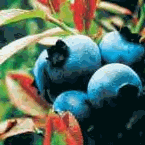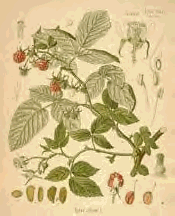


*Stealth Gardening Part 2*
Edible Landscaping Plants-Section 1-Berries
By LabLover
19 May 2004
In Part I, we reviewed why Stealth Gardening is attractive to Preppers, and how to plan your Edible Landscape. Part II will, I hope, give you some ideas on particular plants to add to your Landscape plan. I’ll add Part 2 sections on each different type of edible-berries, fruits, vegetables, herbs and others- as I finish them. These are by no means exhaustive lists. Altering your landscape to do double duty by producing edibles as well as beauty is a creative endeavor-the options are only limited by your climate, gardening interest and imagination.
What to Plant
The basic rule for food growing is very similar to the one for food storage-plant what you eat! Try it before you buy (or plant) it whenever possible. Favor low maintenance hardy perennials over lower yielding or disease prone biennials and annuals. If the time comes when your Edible Landscape really matters, plants that grow and yield reliably under adverse conditions and "benign neglect" will be asset. You’ll be busy enough with other things…
The following table included with each entry will help you compare the plants available for your Edible Landscaping project. I’ve collated info from the excellent and highly recommended book Edible Landscaping by Rosaland Creasy (ISBN 0-87156-249-9), various other web and printed gardening resources, and my own experience. Corrections and additional information from your own experience are solicited by the author. I hope Rubies in the more extreme climate areas, especially Zones 3 and under or 9 and over- will be able to share what plants and varieties work for them.
|
Common Name- Botanical name |
|||||
|
Hardiness Zone |
Mature Height |
Water Requirements |
Light Requirements |
Disease Susceptibility |
Annual, Perennial, Biennial |
|
A thumbnail sketch of information about the plant or recommended variety. If you’re uncertain, a quick search on the net will provide more information to help you decide. |
|||||
Commonly Available Berries
Your regular gardening space might not have enough room for fruits and berries. So including them in your ornamental landscape just makes sense! Here are some of the most commonly chosen options that are likely to be available at your local garden center or discount store gardening department. If the plants are at your local WalMart, you can be fairly certain they will do OK in your climate. Don’t hesitate to be creative with other varieties – just check the Zone, water and light requirements to increase your likelihood of success.



|
Blueberry- Highbush, Vaccinium corymbosum Lowbush,V. angustifolium Rabbiteye, V. ashei |
|||||
|
Hardiness Zone |
Mature Height |
Water Requirements |
Light Requirements |
Disease Susceptibility |
Annual, Perennial, Biennial |
|
Highbush 5-8 Lowbush 3-7 Rabbiteye 7-10 |
Highbush 5-6’ Lowbush 1-3’ Rabbiteye-up to 18’ |
Thirsty, prefer moister soils or areas, Rabbiteyes tolerate drier hot conditions |
Yields better in full sun, some mild shade OK, lowbush tolerates shade better in my experience |
Moderate, good air circulation helps prevent problems. Don’t crowd them too much! |
Perennial |
|
Requires acid soil- prefers pH about 4.5. Mulch with acid producing mulch such as pine needles or oak leaves. A little azalea fertilizer helps until they’re established. Plant more than one variety for better yield. Most plants will yield 5-6 pints each when mature. Berries dehydrate and freeze or can well, too many is not a problem! Consider a blueberry hedge-the berries you don’t harvest will help wildlife. Yields well in 3-4 yrs. |
|||||
|
Raspberry Red, Rubus idaeus Black, R. occidentalis |
|||||
|
Hardiness Zone |
Mature Height |
Water Requirements |
Light Requirements |
Disease Susceptibility |
Annual, Perennial, Biennial |
|
3-9 (red hardier than black) |
5-26’ depending on species |
Average Not good for desert or very dry areas |
Full sun, may tolerate light shade-light shade better south of the Mason-Dixon line |
Not usually bothered by insects. Choose certified virus free plants |
Perennial |
|
Plant @ 3 ft apart for a great impenetrable hedge dogs, children and (under house windows) even burglars avoid! Manure ground before planting, mulch with compost or leaves. Too much fertilizer makes lots of leaves and little fruit. Taller varieties need a fence or staking. Bear on second year canes-the exception are the varieties called Everbearers- they give a crop in spring and another small one in the fall- or you can mow them to the ground just after frost, and they will regrow and bear once the following year. Prune the canes (branches) that have fruited late fall in all varieties to keep plant under control-or you may end up with an impenetrable thicket. Easy to propagate by suckers or ground layering, even cuttings usually root with little effort. Few pests, wilting foliage may mean borers-cut off and burn the wilted canes to control. Black raspberries are more disease prone than red. There are some new delicious yellow Everbearers available that may look just perfect in your landscape. |
|||||
|
Currants – Ribes sativum and Gooseberries- R. hirtellum |
|||||
|
Hardiness Zone |
Mature Height |
Water Requirements |
Light Requirements |
Disease Susceptibility |
Annual, Perennial, Biennial |
|
3-8 |
3-5’ |
Average Not good for very hot, dry areas |
Full sun in the north, tolerate shade better than most plants, 3-4 hrs sun only in the south |
Hosts to White Pine Blister rust. Some states will not allow them |
Perennial |
|
Good foundation plants in moderate shade or under trees. Some gooseberries have a weeping shape and can cascade over walls. Gooseberries can have large thorns- choose thornless varieties for easy picking, or thorny ones for security. Mulch generously. Average garden soil, pH 5.0-7.0. Good drainage. Do not plant near pine trees. Prune each spring to @ 10 canes- 1/3 each of 1, 2 and 3 yr old canes for best yield. Pink or purple varieties are sweeter-pick when ripe or pucker up! Currants should be picked a bit under-ripe for jams or jellies, but ripe ones dehydrate well into miniature, tart raisins. Currents yield about 2-3 qts., gooseberries 3-4. qts. per plant. Some pests, but they tend to tolerate most without loosing production. Both can, freeze and pickle well. |
|||||
All materials at this site not otherwise credited are Copyright (c) 1996-2004 Trip Williams. All rights reserved. May be reproduced for personal use only. Use of any material contained herein is subject to stated terms or written permission.